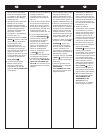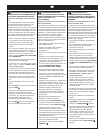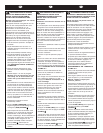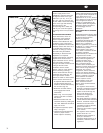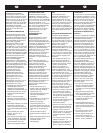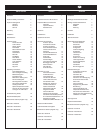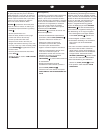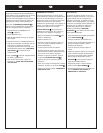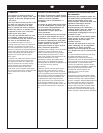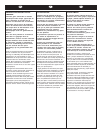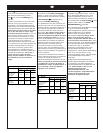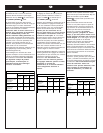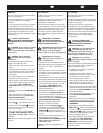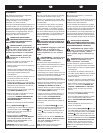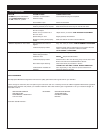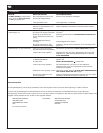
36
I D
SPEED/TEMPERATURE GUIDE AND THE ART
OF LAMINATION
Do not attempt to laminate abrasive or
metal objects such as staples, paper clips
and glitter, as they may damage the heat
or pull rollers.
Do not force items into the nip area of the
heat rollers. An item that is not easily
drawn into the laminator by the heat
rollers is probably too thick to laminate.
Wrinkles may result if an attempt is made
to reposition an item once it has been
grasped by the heat rollers.
Do not stop the laminator before an item
has completely exited the pull rollers.
Even a momentary stop will cause a mark
(heat line) on the laminated item.
Good, consistent lamination is a result of
combining proper heat, tension and dwell time.
Dwell time is controlled by the speed of the
motor and is defined as the amount of time the
material to be laminated is compressed between
the heat rollers. When selecting film gauge, the
laminator automatically sets the speed and
temperature for that film and 20 lb. paper
(copier paper).
As a general rule, thicker items and film need to
run at slower speeds because they extract
more heat from the rollers at a quicker rate.
Setting the speed control at slower settings
gives the laminator longer dwell time thus
allowing proper lamination of thick items.
Thinner items, such as standard copier paper
(20 lb. bond) and tissue paper, extract less heat
from the rollers and can be run at faster
speeds.
GUIDA ALLE VELOCITÀ/TEMPERATURA E
L’ARTE DELLA PLASTIFICAZIONE
Non tentare di plastificare oggetti abrasivi
o in metallo come punti metallici, graffette
o lustrini, in quanto potrebbero
danneggiare i rulli di riscaldamento o i
rulli tenditori.
Non forzare gli articoli nella zona di presa
dei rulli di riscaldamento. Un articolo che
non viene tirato nella plastificatrice dai
rulli di riscaldamento con facilità,
probabilmente è troppo spesso per
essere plastificato.
Cercare di riposizionare un articolo dopo
che questo è stato afferrato dai rulli di
riscaldamento può causare corrugamenti.
Non fermare la plastificatrice prima della
completa fuoriuscita di un articolo dai rulli
tenditori. Persino una fermata
momentanea causerà un segno (linea di
calore) sull’articolo plastificato.
Una plastificazione costante e di buona qualità è
il risultato di un giusto equilibrio tra calore,
tensione e tempo di sosta. Il tempo di sosta è
controllato dalla velocità del motore e viene
definito come la durata della compressione del
materiale da plastificare tra i rulli di
riscaldamento. Quando viene selezionato lo
spessore del film, la plastificatrice imposta
automaticamente la velocità e la temperatura del
film e per carta da 20 lb. (carta per
fotocopiatrici).
Solitamente, articoli e film più spessi devono
essere lavorati a bassa velocità, in quanto
estraggono maggior calore dai rulli per unità di
tempo. L’impostazione del controllo di velocità su
valori più bassi consente alla plastificatrice di
aumentare i tempi di sosta, permettendo così
una plastificazione migliore degli articoli più
spessi. Articoli sottili, come ad esempio carta
per fotocopiatrici standard (20 lb.) o carta
velina, estraggono minore quantità di calore dai
rulli e possono essere lavorati a velocità più
alte.
GESCHWINDIGKEITS- UND
TEMPERATURRICHTLINIEN UND DIE KUNST
DES LAMINIERENS
Scheuernde oder metallene Artikel, wie
z.B. Heftklammern, Büroklammern, sowie
Artikel mit Glanzeffekt dürfen nicht
laminiert werden, da diese die Heiß- oder
Zugwalzen beschädigen könnten.
Die Artikel dürfen nicht in den
Berührungsbereich der Heißwalzen
gezwängt werden. Wenn ein Artikel von
den Heißwalzen nicht leicht in das
Laminiergerät hineingezogen wird, ist er
vermutlich zu dick.
Wenn ein Artikel von den Walzen einmal
erfasst worden ist, darf er nicht mehr
bewegt werden, da sonst Falten
entstehen können.
Halten Sie das Gerät nicht an, bevor der
Artikel vollständig aus den Zugwalzen
ausgetreten ist. Sogar ein kurzes
Anhalten verursacht aufgrund der Hitze
einen Streifen auf dem zu laminierenden
Artikel.
Eine gute einheitliche Laminierung wird durch
die richtige Kombination von Hitze,
Zugspannung und Verweilzeit erzielt. Die
Verweilzeit wird durch die Geschwindigkeit des
Motors gesteuert und wird als die Zeit definiert,
während der die zu laminierenden Artikel
zwischen die Heißwalzen gepresst werden.
Wenn eine bestimmte Foliendicke gewählt wird,
stellt sich das Gerät automatisch auf die
entsprechende Geschwindigkeit und
Temperatur sowie auf 20 lb. Papier
(Kopierpapier) ein.
Als allgemeine Regel gilt, dass dickere Artikel
und Folien langsamer laufen sollen, weil diese
den Walzen schneller mehr Wärme entziehen.
Bei einer niedrigeren Geschwindigkeitsstufe hat
das Laminiergerät eine längere Verweilzeit,
wobei eine gute Laminierung von dickeren
Artikeln erzielt werden kann. Dünnere Artikel,
wie z.B. normales Kopierpapier (20 lb.) und
Seidenpapier entziehen den Walzen weniger
Wärme und dürfen daher schneller durchlaufen.



